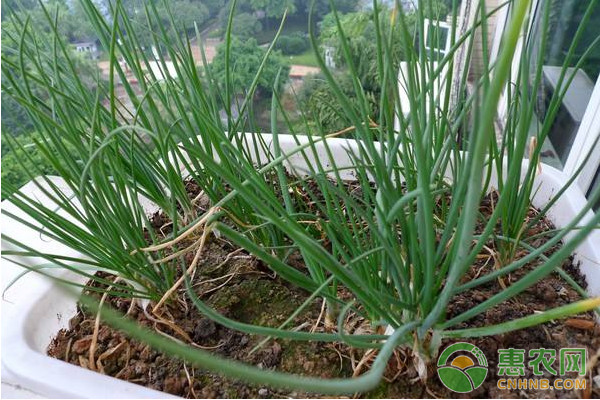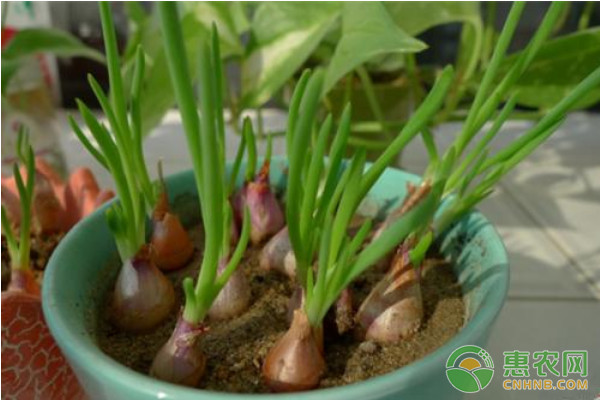How can scallions be grown to achieve high yields? Main points of high-yield planting management techniques
How to grow chives? Shallot is an important ingredient in people's diet. The following is a compilation of a high-yield cultivation management technique for chives.

First, the characteristics and characteristics of the shallot
The plants are erect, short, and the leaves are in a thin tube shape with a plant height of 32-38 cm. The densely populated plexus is composed of 9-11 tillers per plant in the Xinluo district from January to April, and 6-7 tillers per plant from May to September, and 15-16 tillers per plant from October to December. . The bulbs are small and scallion is 7-15 cm. The root system is developed, the distribution is shallow, and the length is about 5cm. Flowering seed or flowering only seeds, can be sexually propagated, seed seedlings, and ramets.
The chives are hard to withstand heat and heat, and can be cultivated all year round. However, the temperature range most suitable for its growth is 18 ° C - 23 ° C. The roots of the shallots are shallow and not tolerant to drought, and are suitable for growth in loose, fertile soil.
Second, the choice of field
The land should be selected to be flat, the soil should be free from pollution or harmless treatment, drainage and irrigation are convenient, the tillage layer is deep, the structure is suitable, and the physicochemical property is good. The sandy loam or loam is suitable, and the soil organic matter content should be above 1.5%, PH value. Between 6.0 and 7.0.
Third, cultivation management measures
(1) Variety selection
The main varieties are: four seasons rice onions, Sichuan small shallots, Lusong No. 1, Chongzhou horn onions and long-term cultivation of small shallots.
The amount of acres used is 1.2-1.5 kg. Soak seeds in warm water at 55 °C for 20 minutes before sowing, rinse with water, dry and sown. Choose a plot with high dryness and good soil quality, make a sorghum seedbed with a width of 1.2 meters, and apply organic fertilizer as a base fertilizer.
Before sowing, the seedbed is poured into the bottom water, and 4-5 grams of seedlings are planted per square meter of seedbed, then covered with 0.5 cm of fine soil, and watered after suppression. At the same time, cover the sunscreen with a sunscreen or a straw to moisturize. Keep the soil moist before sowing until the leaves are grown.
(2) Colonization
Seedlings should be screened before planting, and diseased plants, disabled plants, and weak plants should be removed. After screening, cut the apex of the roots and leave 2-3 cm to promote the development of new roots. The plants were transplanted at a row spacing of 20 cm and a plant spacing of 10 cm, and 4-6 plants were planted at each hole.
Spring onions, autumn onions can be properly planted, planting should be shallow, about 3 cm -5 cm, timely planting water after planting. Before transplanting, soak seeds with 50% carbendazim WP 500 times for 5-10 minutes, then remove them for planting.
(3) Reasonable rotation
The green onion production area should be rotated with non-onion garlic crops for 2-3 years. The arrangement of rice can be taken from the cultivation mode of rice - chives, corn - chives, flue-cured tobacco - chives.
(4) Site preparation
After harvesting, the plough, exposure and fine soil preparation should be carried out in a timely manner, with a width of 4.5m wide and a north-south direction. The rake surface is 1.2m, the groove width is 0.3m, and the ditch depth is 0.2m. Do the flat ditch straight soil.
(5) timely sowing and reasonable close planting
1, planting time
(1) Spring Festival
Transplanted in January, harvested in the middle and late March to April, in order to grab the morning market, covered with plastic film.
(2) Xia Wei
Transplanted from late April to early June, harvested from May to July. This 茬 can be cultivated with sunshade nets or interplanted in the rows of high-stalk crops to supply the “summer†market.

(3) Autumn
Transplanted from August to September, and listed from mid-late September to November. When the autumn onions are transplanted, the temperature is high, and some rice and wheat straw can be sprinkled between rows to cool down and moisturize.
(4) Winter 茬
Transplanted from October to November, harvested from January to February. In winter, the temperature is low, the growth of the shallots is slow, and the “Yueyan†method is used to supply the New Year’s Day and Spring Festival markets.
2. Seeding density and seed amount
The amount of seed is different due to the size of the onion, the wetness of the onion, the fertility of the soil, the target yield and the production season. Generally, the amount is 120-180kg/mu, and the spring onion is the target product. The row spacing is 10×12cm, 45,000 plants/mu.
3. Seeding method
On the crotch surface, open a shallow groove of 3-4 cm depth perpendicular to the row direction, and then plant according to the plant spacing, and then cover the soil 2-3 cm. If the soil is sticky, the field can also be ordered by plant spacing.
(6) Fertilizer and water management
1, timely irrigation
The roots of the shallots are shallow, not tolerant to drought or tolerant to sputum, and should be irrigated according to the lyrics and seedlings. Xiaochun scallions generally need to be watered 6-7 times during the whole growth period.
2, timely ploughing
After the emergence of shallots, weeding and weeding should be carried out in time according to soil moisture and weed growth to prevent soil compaction and weed growth.
3. Rational fertilization
(1) Fertilization principle
Fertilizer application should strictly implement the fertilizer application guidelines for the production of pollution-free agricultural products, adhere to the fully decomposed organic fertilizers, supplemented by chemical fertilizers; base fertilizers, supplemented by topdressing; multi-component fertilizers, supplemented by single-element fertilizers .
(2) base fertilizer
When planting the land, apply fully degraded farmyard manure 3000-4000kg/mu, superphosphate 50kg/mu, ternary compound fertilizer (N:P:K=15:15:15) 25kg/mu, and the fertilizer should be evenly mixed with the soil.
(3) Topdressing
The roots of the scallions are shallowly distributed and have weak absorption. They are not resistant to heavy fertilizers and are not tolerant to droughts and floods. They must be poured with small water and pay attention to the timely removal of water after rain. After planting the seedlings, combine the watering in time to pursue the Jiamei profit or the internal potassium de 5-8 kg or Jiamei Hailibao 3-5 kg, usually 10-15 days to pursue once, harvest
15 days no longer pursue.
(7) Integrated pest management
1, the principle of prevention
In accordance with the principle of "prevention first, comprehensive prevention", priority is given to agricultural control, biological control, physical control, scientific and rational use of chemical control, and the use of high-toxic and high-residue pesticides is prohibited.
2, prevention and treatment methods
(1) Agricultural control
Use disease-resistant varieties, rational layout, implement crop rotation, seed treatment, rational fertilization, strengthen management of middle-age farming, clean the pastoral, and reduce the source of insects.
(2) Biological control
Protect natural enemies, create environmental conditions conducive to the survival of natural enemies, and choose pesticides with low lethality against natural enemies, such as BT emulsions and agricultural streptomycin.
(3) Physical control
First, every 30-50 mu will be set up with a frequency-vibration insecticidal lamp to trap the adult; the second is to hang 20-30 yellow plates per acre to trap the adult.
(4) Chemical control
1 soil disinfection
When the field of serious pests and diseases occurs, the field is mixed with 50% carbendazim or 70% dikesone 1-2kg plus 3% phoxim granules 1.5kg per mu and mixed with fine soil.
2 major pest control
Onion horses, leaf miners, aphids: can be controlled with 4.5% beta-cypermethrin EC 2000 times or 5% Taibao cream 2500 times.
Downy mildew: In the early stage of the disease, 75% chlorothalonil wettable powder 700 times solution, 80% mancozeb wettable powder 500 times solution, 58% metalaxyl manganese zinc 600 times liquid and other chemicals can be used for prevention and treatment.
Gray mold: In the early stage of the disease, 50% carbendazim WP 500 times solution, 70% thiophanate-methyl WP 500 times solution, 25% metalaxyl WP 1000 times solution can be used for prevention and treatment.
Leaf spot disease, leaf blight: 70% chlorothalonil WP 700 times solution, 64% anti-bacterial WP WP 600 times, 58% metalaxyl manganese zinc 600 times solution or 25% fresh food An agent such as an amine cream 2000 times liquid is used for prevention and treatment.
Anthrax: 25% prochloraz WP 800 times solution, or 25% bromocarbonitrile wettable powder 500 times solution, or 70% methyl thiophanate WP 600 times solution, or 40% more Sulfur suspension 500 times solution, or 2% agricultural anti-120 water solution 200 times liquid spray or watering.
White rot: timely spraying in the early stage of the disease, the chemical control can be sprayed with 70% methyl thiophanate 1000-1500 times solution, or 25% carbendazim 250 times solution, or 40% sclerotia net l000-1500 times solution. Or 130 grams of 70% chloronitrobenzene powder per acre, 13 kg of fine soil is sprinkled on the roots. The above pests and diseases are controlled once every 7-10 days, even for 2-3 times, and the medicines should be used alternately.
(8) Harvesting at the right time
It should be chosen in the warm and sunny weather as it is beneficial to maintain the quality and quality of the scallions.
The above is today's high-yield cultivation management technology for scallions. Xiao Bian also reminds everyone that the above-mentioned medicinal agents are not recommended. For specific drug use, you can consult local experienced people.
Fresh Half Shell Mussel Meat,Half Shell Mussel Meat,Frozen Cooked Mussel Meat,Frozen Mussel
Shengsi Huali Aquatic Products Co.,Ltd , https://www.mytilus-edulis.com